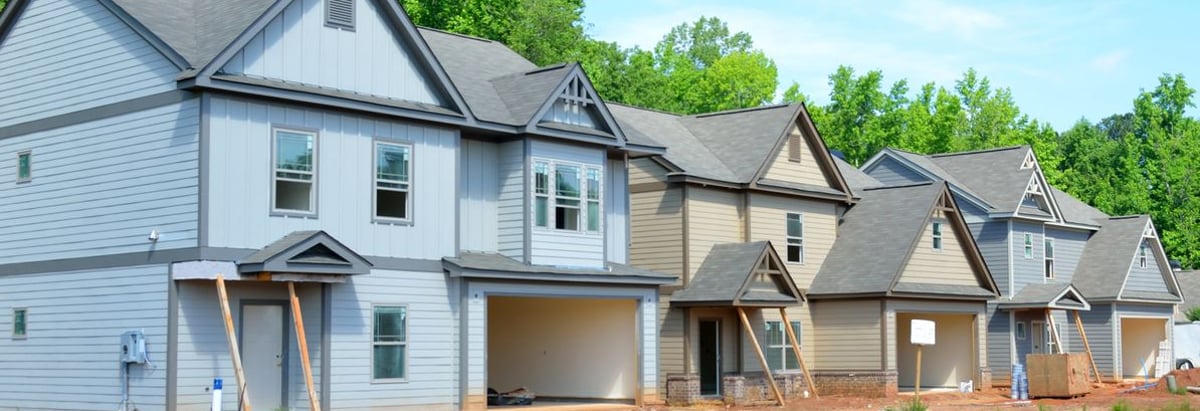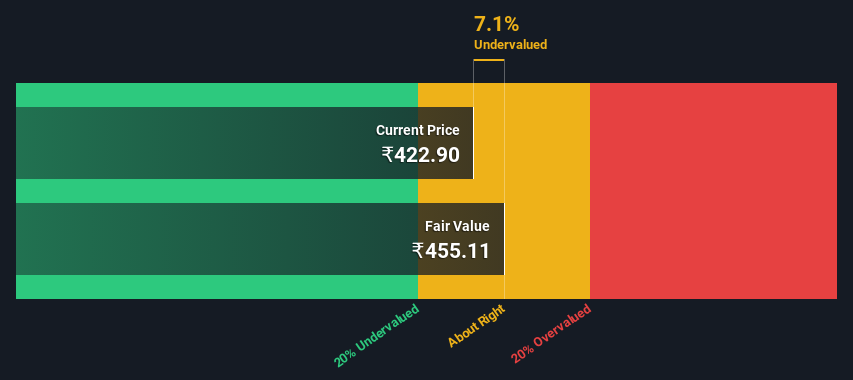- India
- /
- Real Estate
- /
- NSEI:AJMERA
Calculating The Intrinsic Value Of Ajmera Realty & Infra India Limited (NSE:AJMERA)

Key Insights
- Using the 2 Stage Free Cash Flow to Equity, Ajmera Realty & Infra India fair value estimate is ₹455
- Current share price of ₹423 suggests Ajmera Realty & Infra India is potentially trading close to its fair value
- Peers of Ajmera Realty & Infra India are currently trading on average at a 940% premium
Today we will run through one way of estimating the intrinsic value of Ajmera Realty & Infra India Limited (NSE:AJMERA) by taking the forecast future cash flows of the company and discounting them back to today's value. This will be done using the Discounted Cash Flow (DCF) model. There's really not all that much to it, even though it might appear quite complex.
Remember though, that there are many ways to estimate a company's value, and a DCF is just one method. If you want to learn more about discounted cash flow, the rationale behind this calculation can be read in detail in the Simply Wall St analysis model.
Check out our latest analysis for Ajmera Realty & Infra India
Is Ajmera Realty & Infra India Fairly Valued?
We're using the 2-stage growth model, which simply means we take in account two stages of company's growth. In the initial period the company may have a higher growth rate and the second stage is usually assumed to have a stable growth rate. To start off with, we need to estimate the next ten years of cash flows. Seeing as no analyst estimates of free cash flow are available to us, we have extrapolate the previous free cash flow (FCF) from the company's last reported value. We assume companies with shrinking free cash flow will slow their rate of shrinkage, and that companies with growing free cash flow will see their growth rate slow, over this period. We do this to reflect that growth tends to slow more in the early years than it does in later years.
A DCF is all about the idea that a dollar in the future is less valuable than a dollar today, so we discount the value of these future cash flows to their estimated value in today's dollars:
10-year free cash flow (FCF) estimate
| 2024 | 2025 | 2026 | 2027 | 2028 | 2029 | 2030 | 2031 | 2032 | 2033 | |
| Levered FCF (₹, Millions) | ₹1.47b | ₹1.66b | ₹1.83b | ₹2.01b | ₹2.19b | ₹2.37b | ₹2.55b | ₹2.74b | ₹2.94b | ₹3.15b |
| Growth Rate Estimate Source | Est @ 15.10% | Est @ 12.60% | Est @ 10.85% | Est @ 9.62% | Est @ 8.76% | Est @ 8.16% | Est @ 7.74% | Est @ 7.45% | Est @ 7.24% | Est @ 7.10% |
| Present Value (₹, Millions) Discounted @ 17% | ₹1.3k | ₹1.2k | ₹1.1k | ₹1.1k | ₹991 | ₹914 | ₹841 | ₹771 | ₹706 | ₹645 |
("Est" = FCF growth rate estimated by Simply Wall St)
Present Value of 10-year Cash Flow (PVCF) = ₹9.5b
The second stage is also known as Terminal Value, this is the business's cash flow after the first stage. The Gordon Growth formula is used to calculate Terminal Value at a future annual growth rate equal to the 5-year average of the 10-year government bond yield of 6.8%. We discount the terminal cash flows to today's value at a cost of equity of 17%.
Terminal Value (TV)= FCF2033 × (1 + g) ÷ (r – g) = ₹3.1b× (1 + 6.8%) ÷ (17%– 6.8%) = ₹32b
Present Value of Terminal Value (PVTV)= TV / (1 + r)10= ₹32b÷ ( 1 + 17%)10= ₹6.6b
The total value, or equity value, is then the sum of the present value of the future cash flows, which in this case is ₹16b. In the final step we divide the equity value by the number of shares outstanding. Relative to the current share price of ₹423, the company appears about fair value at a 7.1% discount to where the stock price trades currently. Remember though, that this is just an approximate valuation, and like any complex formula - garbage in, garbage out.

Important Assumptions
We would point out that the most important inputs to a discounted cash flow are the discount rate and of course the actual cash flows. If you don't agree with these result, have a go at the calculation yourself and play with the assumptions. The DCF also does not consider the possible cyclicality of an industry, or a company's future capital requirements, so it does not give a full picture of a company's potential performance. Given that we are looking at Ajmera Realty & Infra India as potential shareholders, the cost of equity is used as the discount rate, rather than the cost of capital (or weighted average cost of capital, WACC) which accounts for debt. In this calculation we've used 17%, which is based on a levered beta of 1.249. Beta is a measure of a stock's volatility, compared to the market as a whole. We get our beta from the industry average beta of globally comparable companies, with an imposed limit between 0.8 and 2.0, which is a reasonable range for a stable business.
SWOT Analysis for Ajmera Realty & Infra India
- Earnings growth over the past year exceeded the industry.
- Debt is well covered by earnings.
- Dividends are covered by earnings and cash flows.
- Dividend is low compared to the top 25% of dividend payers in the Real Estate market.
- Current share price is below our estimate of fair value.
- Lack of analyst coverage makes it difficult to determine AJMERA's earnings prospects.
- Debt is not well covered by operating cash flow.
Next Steps:
Although the valuation of a company is important, it ideally won't be the sole piece of analysis you scrutinize for a company. The DCF model is not a perfect stock valuation tool. Instead the best use for a DCF model is to test certain assumptions and theories to see if they would lead to the company being undervalued or overvalued. For example, changes in the company's cost of equity or the risk free rate can significantly impact the valuation. For Ajmera Realty & Infra India, there are three essential factors you should look at:
- Risks: Every company has them, and we've spotted 3 warning signs for Ajmera Realty & Infra India (of which 2 are potentially serious!) you should know about.
- Other Solid Businesses: Low debt, high returns on equity and good past performance are fundamental to a strong business. Why not explore our interactive list of stocks with solid business fundamentals to see if there are other companies you may not have considered!
- Other Top Analyst Picks: Interested to see what the analysts are thinking? Take a look at our interactive list of analysts' top stock picks to find out what they feel might have an attractive future outlook!
PS. The Simply Wall St app conducts a discounted cash flow valuation for every stock on the NSEI every day. If you want to find the calculation for other stocks just search here.
If you're looking to trade Ajmera Realty & Infra India, open an account with the lowest-cost platform trusted by professionals, Interactive Brokers.
With clients in over 200 countries and territories, and access to 160 markets, IBKR lets you trade stocks, options, futures, forex, bonds and funds from a single integrated account.
Enjoy no hidden fees, no account minimums, and FX conversion rates as low as 0.03%, far better than what most brokers offer.
Sponsored ContentNew: Manage All Your Stock Portfolios in One Place
We've created the ultimate portfolio companion for stock investors, and it's free.
• Connect an unlimited number of Portfolios and see your total in one currency
• Be alerted to new Warning Signs or Risks via email or mobile
• Track the Fair Value of your stocks
Have feedback on this article? Concerned about the content? Get in touch with us directly. Alternatively, email editorial-team (at) simplywallst.com.
This article by Simply Wall St is general in nature. We provide commentary based on historical data and analyst forecasts only using an unbiased methodology and our articles are not intended to be financial advice. It does not constitute a recommendation to buy or sell any stock, and does not take account of your objectives, or your financial situation. We aim to bring you long-term focused analysis driven by fundamental data. Note that our analysis may not factor in the latest price-sensitive company announcements or qualitative material. Simply Wall St has no position in any stocks mentioned.
About NSEI:AJMERA
Ajmera Realty & Infra India
Engages in the real estate development business in India.
Solid track record with adequate balance sheet and pays a dividend.
Similar Companies
Market Insights
Community Narratives



